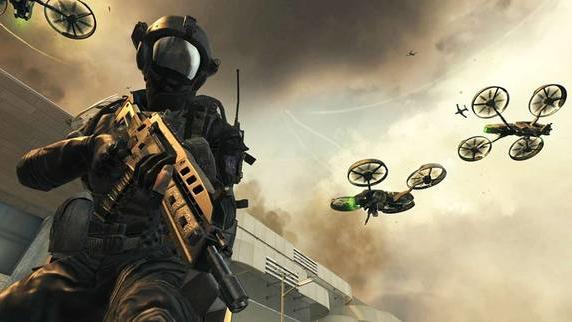Downtown Los Angeles is being torn apart by hijacked U.S. military robots. The U.S. and China are locked in a new Cold War over control of rare earth minerals. It's a chilling glimpse of the world in 2025, but luckily it's just a video game — at least until the U.S. military turns one of the game's fictional drones into reality.
The upcoming video game "Call of Duty: Black Ops 2" has somehow managed to inspire the U.S. military well before hitting store shelves in November. Treyarch, the game's producer, released a viral marketing video on April 23 showing a mock "real-life" demonstration of an armed quadrotor drone similar to flying robots featured in the game. That led a Pentagon office to wonder if the U.S. military could make the same thing, said Peter Singer, director of the 21st Century Defense Initiative at the Brookings Institute.
"You see this [science fiction inspiration] in everything from what scientists decide to invent to what Congress and the military decides to fund," Singer said. "It shapes expectations when people think 'This is what the future is going to be, so we should invest in that today.'"
Singer usually consults on future war technologies with U.S. military officers and government policymakers. But he happily lent his expertise to shaping the fictional universe of the latest game in the popular "Call of Duty" franchise.
Such fictional stories represent entertainment first and foremost rather than educational tools or predictions of the future, Singer said. But he also pointed out how science fiction has shaped real-life visions and expectations of warfare — whether it's the Nautilus submarine described by Jules Verne in 1870 or H.G. Wells' vision of tanks in the 1903 short story "The Land Ironclads." [INFOGRAPHIC: Rise of the Drones]
"I say it half in jest, but I think some of my work on the fiction side will have as much impact as my work on the nonfiction side," Singer told InnovationNewsDaily.
Singer also saw similarities between helping Treyarch plot out the storyline for its "Call of Duty" game and helping military analysts plan for future scenarios. Many of the game's ideas — such as fighter jets capable of flying themselves and walking robots mounted with turrets — arose from real technologies described in Singer's book "Wired for War: The Robotics Revolution and Conflict in the 21st Century" (Penguin Press HC, 2009).
"There's an infinite amount of potential futures that might play out — this is not a predictor," Singer said. "On the other hand, we can right now identify key trends and key technologies that will be very important in shaping that future."
Early marketing for the newest "Call of Duty" has focused on China's production monopoly over rare earth minerals used in all high-tech devices such as smartphones, HDTVs, wind turbines, electric cars and guided missiles. That represents part of a bigger trend with growing tensions between the U.S. and China over political, military and economic issues, even if the game tries to defuse open hostility by adding the manipulations of an independent villain.
The game also emphasizes the robotic and cyber nature of conflict in one mission in which a terrorist hijacks the military's drone swarms. The U.S. military has already deployed thousands of battlefield drones and robots in real life, and experts have already begun discussing their possible vulnerabilities to being jammed or hacked by potential enemies.
Whether or not "Call of Duty" influences the real-world military and possibly the future, Singer enjoyed "scratching that creative itch" as a consultant to Treyarch. He said he constantly sent the game developers breaking news updates on technology and war that tied in well with the game's fiction — maybe even too well.
"It was funny to see the real world start to catch up with things we were playing with on the fictional side," Singer said.
This story was provided by InnovationNewsDaily, a sister site to LiveScience. You can follow InnovationNewsDaily Senior Writer Jeremy Hsu on Twitter @ScienceHsu. Follow InnovationNewsDaily on Twitter @News_Innovation, or on Facebook.
- 10 Sci-Fi Predictions That Came True
- INFOGRAPHIC: Energy-Critical Elements to Watch
- Top 7 Useful Robots You Can Buy Right Now
- Arts & Entertainment
- Military & Defense
- Peter Singer











